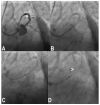Technical Complications of Coronary Bifurcation Percutaneous Interventions
- PMID: 36431278
- PMCID: PMC9694633
- DOI: 10.3390/jcm11226801
Technical Complications of Coronary Bifurcation Percutaneous Interventions
Abstract
Coronary bifurcation percutaneous interventions (PCI) comprise a challenging subset of patients with coronary artery disease. Beyond the well-known debate about single versus double stent strategies, which have different outcomes on mid- and long-term follow up, both strategies may be subject, although rarely, to several different technical complications, rarely reported in clinical trials, which need to be defined, classified, and understood by cardiovascular professionals involved in the management of patients with coronary bifurcation disease. The present paper aims to broaden the knowledge of the range of intraprocedural complications and relative treatment during PCI of coronary bifurcations.
Keywords: complications; coronary artery disease; coronary bifurcation; percutaneous coronary interventions.
Conflict of interest statement
The authors declare no conflict of interest.
Figures







References
-
- Rigatelli G., Zuin M., Gianese F., Adami D., dell’Avvocata F., Barison S., Mazza A., Picariello C., Roncon L. Ultrathin Biodegradable-Polymer Orsiro Drug-Eluting Stent Performance in Real Practice Challenging Settings. Cardiovasc. Revasc. Med. 2021;30:12–17. doi: 10.1016/j.carrev.2020.09.027. - DOI - PubMed
-
- Kim Y.H., Lee J.H., Roh J.H., Ahn J.M., Yoon S.H., Park D.W., Lee J.Y., Yun S.C., Kang S.J., Lee S.W., et al. Randomized Comparisons Between Different Stenting Approaches for Bifurcation Coronary Lesions with or without Side Branch Stenosis. JACC Cardiovasc. Interv. 2015;8:550–560. doi: 10.1016/j.jcin.2015.01.016. - DOI - PubMed
Publication types
LinkOut - more resources
Full Text Sources
Miscellaneous

